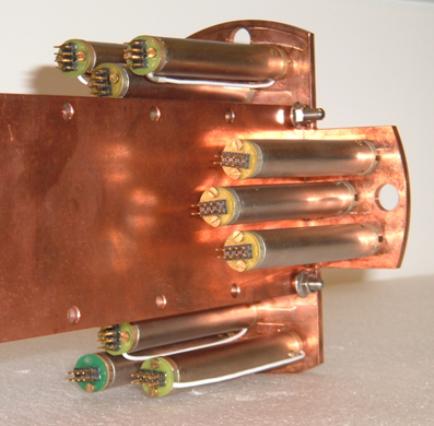|
SQUID magnetometry for cryoEDM We have
developed a 12-channel SQUID magnetometer to measure the magnetic field
in the cryoEDM experiment. This will allow us to track changes in the
field during neutron EDM measurements and correct shifts in the spin
precession frequency.
Both the pick-up loops and the SQUID
sensors are inside superfluid helium. The pick-up loops measure the
magnetic field inside the Ramsey Cell, where the neutrons are stored.
The SQUID sensors are located outside of the magnetic shields, as the
cables carrying the bias current to the SQUID sensors generate a
significant magnetic field. The pick-up loops are connected to the
sensors by twisted wire pairs, which run inside superconducting
capillaries made from solder wire with the flux removed. We have also
installed heaters, to heat the loops into their conducting state if
necessary; and a set of calibration coils. We are currently working on
the electronics and software required to control this.
As this will be the first time a SQUID magnetometer is used in an EDM
experiment, we anticipate some further challenges. It will be necessary
to determine the best way to measure the different components of the
magnetic field; extrapolate this away from the pick-up loops; and
integrate these measurements over an experimental cycle.
As
measurements taken in our Oxford laboratory are limited by the noisy
environment, we tested a smaller version of our system in the very low
noise environment at the Laboratoire
Souterrain à Bas Bruit (LSBB) in Rustrel, Provence, France. This
system worked very well, limited by the magnetic field of the Earth.
References
A SQUID magnetometry system for a cryogenic neutron electric dipole moment experiment
S. Henry, C. Clarke, A. Cottle, M. Pipe, Nuclear Instruments and Methods in Physics Research A, 763 (2014) 483-494.
Characterisation of superconducting capillaries for
magnetic shielding of twisted-wire pairs in a neutron electric dipole moment experiment
S. Henry, M. Pipe, A. Cottle, C. Clarke, U. Divakar and A. Lynch,
Nuclear Instruments and Methods in Physics Research A, 763 (2014) 155-162.
SQUID
magnetometry for the cryoEDM experiment -- Test at LSBB, S Henry et
al., Journal of Instrumentation 3 (2008) P11003.
|





